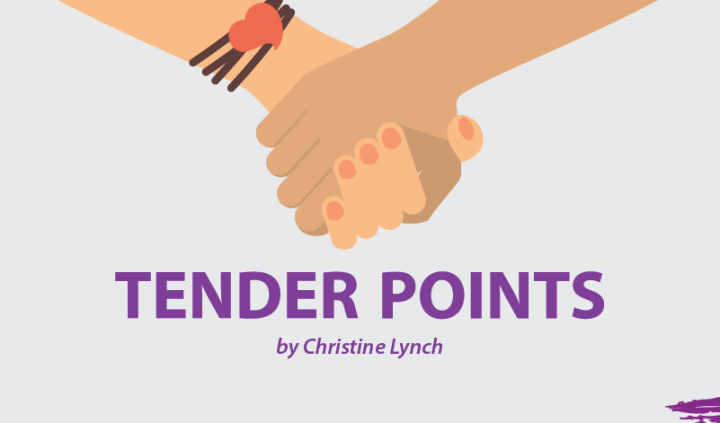After decades of reading about, treating, and often cursing this challenging illness called fibromyalgia, one significant thing I’ve learned is that pain has two parts: There’s the actual physical sensation and then the feeling about that physical sensation.
The physical sensation usually is measured on a severity scale of 1- 10 and includes a longevity factor (how long you’ve experienced this unpleasantness).
In other words, there’s pain and then there’s the reaction to pain.
In many cases, we are powerless to control the physical sensation. Sometimes, all the treatments we generally employ — heat, ice, medication, meditation, yoga, massage, acupuncture, and aromatherapy — just don’t do it. Or, they don’t do it quickly enough. That’s when the going gets tough. But that’s when we need to think about other options.
Once we realize we are powerless to change our physical condition, the options become psychological, or perhaps even spiritual, in nature. One choice is to be angry about the pain. The thing to know about anger is that it’s always a secondary emotion. When we’re in pain, the primary emotion for most of us is likely fear — that it will get worse or that it won’t stop.
Interestingly, anger can feel good in the short term. While you’re focused on your anger, you’re less focused on your pain. However, anger isn’t stagnant, and it always has a target. Someone in your life (often the person closest to you) will likely suffer along with you. This is never helpful.
However, if you can convert your anger into its opposite, which is assertiveness, and maintain your pain as your target, it may serve you well. For example, if your anger says, “I’ve had enough of feeling this way, and today I’m going to do something about it,” then anger can be useful. If you can be angry enough to take a short walk, even if it hurts, or throw away your sugary treats and make yourself an energy drink, then your anger served a purpose.
Another psychological option is to have a pity party. I must admit, this choice is all too tempting for me. Thoughts that are all too common include: Woe is me. I was supposed to attend a special event today, but I’ll be lucky to struggle into my clothes instead. My mind tends to dwell on the past, and it’s difficult to see a brighter future. Thoughts like this tend to make us feel powerless, as we wait for someone else to save us from our problems. Of course, this won’t happen. Pain is personal. It’s only a problem for us — not for anyone else.
The alternative to anger and self-pity is compassion. It’s treating yourself as you’d treat a friend who was going through a similar difficulty. It’s realizing that life isn’t always easy. There will be good times and bad. It’s knowing that we’ve felt this way before and that it won’t last forever. It’s viewing our pain as an outsider looking in, and not having feelings about it one way or another, just feeling what we’re feeling, acknowledging it, accepting it, and treating it (and ourselves) kindly.
***
Note: Fibromyalgia News Today is strictly a news and information website about the disease. It does not provide medical advice, diagnosis, or treatment. This content is not intended to be a substitute for professional medical advice, diagnosis, or treatment. Always seek the advice of your physician or other qualified health provider with any questions you may have regarding a medical condition. Never disregard professional medical advice or delay in seeking it because of something you have read on this website. The opinions expressed in this column are not those of Fibromyalgia News Today, or its parent company, BioNews Services, and are intended to spark discussion about issues pertaining to fibromyalgia.



I don’t have fibromyalgia. But I do have a neck that was broken 40 years ago and was never detected or treated – my spine looks like a ladder crushed under weight. The nerves to my arms, wrists and hands are increasingly constrained/chocked. And I have other severe trauma injuries and the arthritis that comes with them. I’ve had regular Rx for narcotics for 10+ years.
So when someone asks me about my pain on a level of 1 – 10 I have to laugh. And I do, literally. I’ve come to deal with the pain for a long time. I’ve gotten used to it. It’s not actually pain like if you jabbed a knife into yourself. But it is a profound level of dis – ease, distraction, inability to think, concentrate or to even hold a position.
Addiction? Heck yes, but not to a buzz or high. I’m addicted to functionality. I’m in otherwise excellent shape and active. And I can/will continue to do so. But the meds as required are profoundly important. People who don’t live with these conditions haven’t a clue or way to empathize.
Well said JR. Thanks for commenting. It helps some to know we are not alone. Keep your head and God bless.
Thank you for this article which so eloquently describes exactly how I feel about chronic pain from sciatica. Feeling the pain is only half the experience; for me there are only two levels – barely bearable and unbearable. And then there is reaction to the pain, which I am constantly monitoring. My secondary emotion is usually frustration at not being able to complete a task. My response is to find a way, and when I do, I give myself a big smile and a feel those endorphins.
I now have had an MD and a pharmacist tell me my dose of oxy is that of a dying cancer patient ( 60 mg / 24hrs ). Of course, that’s an exaggeration; it was written by my FP doc of 25yrs. My questions to the Pharm. was for education, however, he still walked away from me mid-question. Pain is not our only brick wall. Do I have to leave the US to get my pain treated…………..?